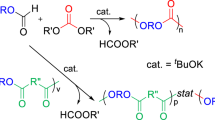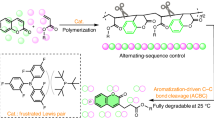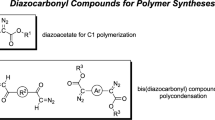Abstract
The mechanism for the copolymerization of carbon dioxide and propylene oxide using diethylzinc–benzenedicarboxylic acid and zinc oxide–benzenedicarboxylic acid systems as catalysts was investigated. The aromatic residue originating from the catalyst systems was confirmed to combine with the copolymer chain by gel permeation chromatographic studies. From the molar concentration of the aromatic residue per weight of the copolymer and the number average molecular weight, one aromatic residue was found to be incorporated into each copolymer chain when diethylzinc-based systems were used as catalysts. Thus, the copolymerization of carbon dioxide and propylene oxide is considered to be initiated by the insertion of a monomer into a zinc-carboxylate bond of the catalysts.
Similar content being viewed by others
Log in or create a free account to read this content
Gain free access to this article, as well as selected content from this journal and more on nature.com
or
References
For a review: S. Inoue and N. Yamazaki, Ed., “Organic and Bioorganic Chemistry of Carbon Dioxide,” Kodansha, Tokyo, 1981, p 167.
M. Kobayashi, S. Inoue, and T. Tsuruta, Macromolecules, 4, 658 (1971).
M. Kobayashi, Y. Tang, T. Tsuruta, and S. Inoue, Makromol. Chem., 169, 69 (1973).
M. Kobayashi, S. Inoue, and T. Tsuruta, J. Polym. Sci., Polym. Chem. Ed., 11, 2383 (1973).
S. Inoue, T. Takada, and H. Tatsu, Makromol. Chem., Rapid Commun., 1, 775 (1980).
K. Soga, E. Imai, and I. Hattori, Polym. J., 13, 407 (1981).
Author information
Authors and Affiliations
Rights and permissions
About this article
Cite this article
Hino, Y., Yoshida, Y. & Inoue, S. Initiation Mechanism of the Copolymerization of Carbon Dioxide and Propylene Oxide with Zinc Carboxylate Catalyst Systems. Polym J 16, 159–163 (1984). https://doi.org/10.1295/polymj.16.159
Issue date:
DOI: https://doi.org/10.1295/polymj.16.159



